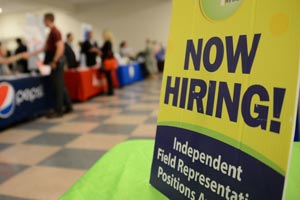Jobless Claims Decline by 10,000 for Week

Jobless claims decreased by 10,000 to 307,000 in the week ended Jan. 17, from a revised 317,000 in the prior period, a Labor Department report showed.
The median forecast of 52 economists surveyed by Bloomberg News called for a decline to 300,000.
Holiday staffing needs create swings in employment, making it difficult for the government to seasonally adjust its weekly data this time of year. Employment is likely to keep growing as the world’s largest economy shows signs it’s sustaining momentum amid a global slowdown.
“It has to do with noise surrounding the end of the holiday season,” said Guy Berger, an economist at RBS Securities Inc., who projected a drop to 308,000. “There isn’t any real sign that layoffs are picking up in any real sense. It seems like the labor market is entering 2015 in pretty good shape.”
No states estimated jobless claims last week, and there was nothing unusual in the report, a Labor Department spokesman said.
Economist estimates in the Bloomberg survey ranged from 280,000 to 315,000 claims. The Labor Department revised the previous week’s figure from an initially reported 316,000.
The four-week moving average, a less volatile measure than the weekly figures, climbed to 306,500 last week, the highest since mid-July, from 300,000.
The number of people continuing to receive jobless benefits increased by 15,000 to 2.44 million in the week ended Jan. 10. The unemployment rate among people eligible for benefits held at 1.8%. These data are reported with a one-week lag.
So far, there is little evidence that the oil slump is causing an increase in firings in the U.S. fuel belt. Texas, which showed the second-biggest increase in claims for the week ended Jan. 10, didn’t cite energy companies among those showing a rise in dismissals.
Initial jobless claims reflect weekly firings and typically decline before job growth accelerates.
President Obama highlighted other positive labor market figures, including surging payrolls and low unemployment during his State of the Union address on Jan. 20.
“Tonight, we turn the page,” Obama said in his sixth annual address. “We have risen from recession freer to write our own future than any other nation on Earth.”
The economy’s performance in the past two quarters — an average of 4.8% growth — was the strongest in a decade. Private employers, excluding government agencies, added about 280,000 workers in each of the past three months, the highest quarterly average since early 2006. Consumer confidence in January reached an 11-year high.
Along with cheaper gasoline prices, a firming job market is stimulating consumer spending, the biggest part of the U.S. economy, which has emerged as a stand out as global peers struggle.
Global fragility and inflation will be on the agenda when policymakers meet Jan. 27-28. The Federal Open Market Committee said last month it will be “patient” in raising interest rates for the first time since late 2008. Investors are betting the Fed will delay the increase to later this year.
Weakening global markets pose the main threat to the outlook for an otherwise robust economy, according to a member of the FOMC.
“Maybe the data will push us a little bit further one way or the other,” John Williams, the San Francisco Fed’s president, told reporters Jan. 16. “I think the good news here is the economy has improved a lot, we’re in a pretty good place.”
Lower oil prices and a stronger dollar are lessening the cost of U.S. imports, which would serve to subdue near-term inflation, Williams said.
Global risks are on the minds of U.S. bank executives. Strong fourth-quarter earnings at Dallas-based Comerica Inc.indicate that consumer spending and improving employment will be able to drive growth.
“We expect stronger labor markets, increasing business and consumer confidence, and solid consumer spending to be positive factors for the national economy in 2015,” Ralph Babb, the company’s CEO, said on a Jan. 16 earnings call. “Of course, global, geopolitical tensions and a cooler European economy could be headwinds for the U.S. economy in 2015.”

